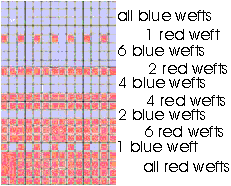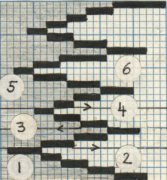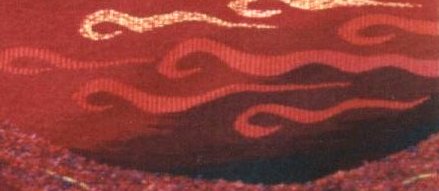|
To change from one color to another or from one shade to another horizontally, without having a distinct dividing line between colors/shades one can blend the colors by weaving them in gradually as shown in the graph. I used contrasting red and blue to show up the sequence.
|

|
|
To change colors or shades vertically, we use a technique called hatchures. The graph shows this process with 2 different colors. I start both wefts next to each other then continue weaving with the left color weaving large steps on the turn back, (see 1), then I follow these steps with the second color (see 2). reaching the end I weave large steps on my turn back. The I follow these steps with the first color, repeat for the length that the color change is required. Varying the length and thickness of each hatchure, makes the colors blend better.
|

|
This shows hatchures between 3 colors.
I start all 3 weft colors at each color's initial position and length, then starting at the left, (start) I weave half the width(1), continue with half of color2 (2), follow with half of color (3), finish the other half of color 3 do (4), follow with second half of color2 (5) and add color 1 second half (5), -repeat from the start again.
Again you need to change the position of the start and length of hatchures to make the color blending more effective, but regular hatchures can be used as effect.
|

|
For the time being, this is the last page about tapestry weaving techniques.
|

Diagonal color change in background using hatchures.
Detail of tapestry "Feeling II"
|